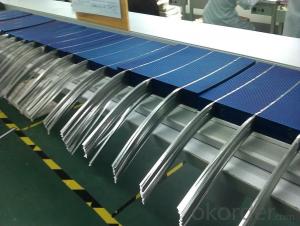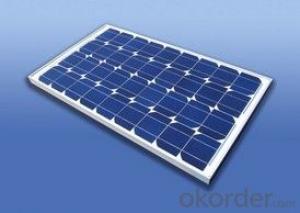Monocrytalline Silicon Solar Cells 125mm (16.50%----18.35%)
- Loading Port:
- Shanghai
- Payment Terms:
- TT OR LC
- Min Order Qty:
- 1000 watt
- Supply Capability:
- 100000000 watt/month
OKorder Service Pledge
OKorder Financial Service
You Might Also Like
Item specifice
1.Description of the Solar Cells
Monocrytalline Silicon Solar Cells 125mm (16.50%----18.35%)
We supply regular mono 125x125mm and poly 156x156mm solar cells.
Cells made in China mainland and Taiwan are both available.
Cell production capacity yearly reach 1GW.
Our cells pattern include continuous and uncontinuous busbar to meet different cells line.
2.Mechanical data and design of the Solar Cells
| Format | 125 mm × 125 mm ± 0.5 mm |
| Thickness- | 210 μm ± 40 μm |
| Front (-) | 1.6 mm bus bars (silver),blue anti-reflection coating (silicon nitride) |
| Back (+) | 2.5 mm wide soldering pads (silver) back surface field (aluminium) |
3. Temperature Coefficient of the Solar Cells
| Voc. Temp .coef.%/K | -0.35%/K |
| Isc . Temp .coef.%/K | +0.024%/K |
| Pm. Temp. coef.%/K | -0.47%/K |
4.Electrical Characteristic of the Solar Cells
Efficiency (%) | Pmpp (W) | Umpp (V) | Impp (A) | Uoc (V) | Isc (A) | FF (%) | ||
18.35 | 2.841 | 0.532 | 5.342 | 0.631 | 5.67 | 79.41% | ||
18.2 | 2.817 | 0.53 | 5.319 | 0.631 | 5.64 | 79.16% | ||
18.05 | 2.794 | 0.527 | 5.301 | 0.63 | 5.63 | 78.77% | ||
17.9 | 2.771 | 0.527 | 5.259 | 0.629 | 5.62 | 78.39% | ||
17.75 | 2.748 | 0.526 | 5.224 | 0.629 | 5.61 | 77.88% | ||
17.6 | 2.725 | 0.524 | 5.201 | 0.629 | 5.59 | 77.50% | ||
17.45 | 2.702 | 0.52 | 5.196 | 0.629 | 5.586 | 76.90% | ||
17.3 | 2.678 | 0.516 | 5.183 | 0.626 | 5.577 | 76.71% | ||
17.15 | 2.655 | 0.513 | 5.175 | 0.623 | 5.565 | 76.58% | ||
17 | 2.632 | 0.51 | 5.161 | 0.622 | 5.559 | 76.12% | ||
16.75 | 2.593 | 0.508 | 5.103 | 0.615 | 5.477 | 76.98% | ||
16.5 | 2.555 | 0.506 | 5.047 | 0.608 | 5.396 | 77.88% | ||
5.Intensity Dependence of the Solar Cells
Intensity [W/m2] | sc× [mA] | Voc× [mV] |
1000 | 1.00 | 1.000 |
900 | 0.90 | 0.989 |
500 | 0.50 | 0.963 |
300 | 0.30 | 0.939 |
200 | 0.20 | 0.920 |
6.IV Curve of the Solar Cells
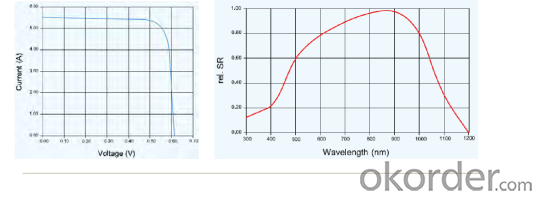
7.Applications of the Solar Cells
electric power generation
8.IMages of the Solar Cells
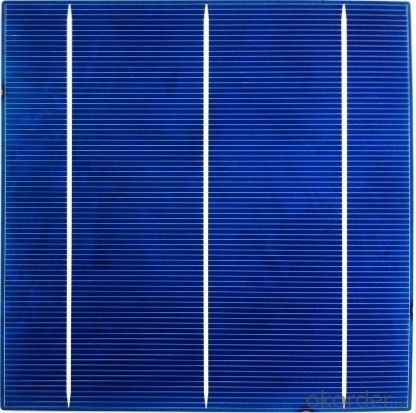

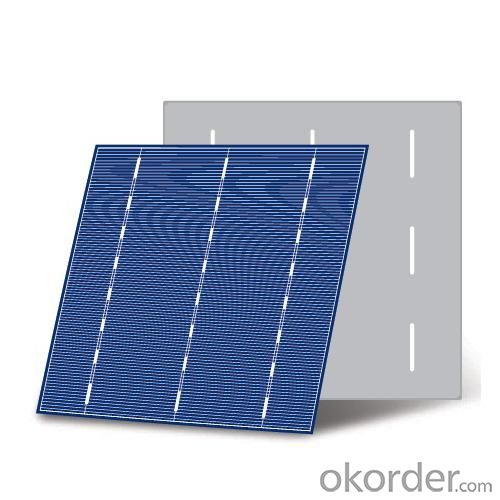
FAQ
- Q:Where can I buy solar cells?
- Usually you need to go to a special store selling power generation products.
- Q:What is the future of solar cells?
- The future of solar cells looks promising as advancements in technology continue to improve their efficiency, affordability, and scalability. With ongoing research and development, we can expect solar cells to become even more efficient in converting sunlight into electricity, allowing for increased energy production. Additionally, innovations such as flexible and transparent solar cells may expand their applications beyond traditional rooftops and solar farms. As the world's demand for renewable energy grows, solar cells are likely to play a crucial role in meeting our energy needs and transitioning towards a sustainable future.
- Q:Can solar cells be used in remote communication systems?
- Yes, solar cells can be used in remote communication systems. Solar cells are an efficient and reliable source of renewable energy that can power various remote communication devices such as satellites, weather stations, and remote sensors. Their ability to convert sunlight into electricity makes them ideal for remote locations where access to grid power is limited or non-existent. Additionally, advancements in solar cell technology have made them more compact, durable, and efficient, further enhancing their suitability for remote communication systems.
- Q:What is the role of power optimizers in solar cell systems?
- Power optimizers play a crucial role in solar cell systems by maximizing the energy output of each individual solar panel. They work by individually monitoring and optimizing the performance of each panel, thereby minimizing power losses caused by shading, mismatch, and other factors. This optimization helps to improve the overall efficiency and reliability of the solar system, ensuring that it operates at its highest potential and delivers maximum energy yields.
- Q:Can solar cells be used in remote monitoring systems?
- Yes, solar cells can be used in remote monitoring systems. Solar cells provide a reliable and sustainable source of energy, making them ideal for powering remote monitoring systems that may be located in areas without access to an electricity grid. They can efficiently convert sunlight into electricity, allowing these systems to operate continuously and independently. Additionally, solar cells are low maintenance and can withstand harsh environmental conditions, making them well-suited for remote monitoring applications.
- Q:What is the impact of dust and dirt on solar cell performance?
- Dust and dirt on solar cell surfaces can significantly impact their performance. They can reduce the amount of sunlight reaching the cells, leading to decreased energy production. The accumulation of dust particles can create a barrier, preventing photons from penetrating the solar cells effectively. This reduces the conversion efficiency and overall power output of the solar panels. Regular cleaning and maintenance are crucial to ensure optimal performance and maximize the energy generation potential of solar cells.
- Q:What is the impact of wind on solar cell efficiency?
- The impact of wind on solar cell efficiency is generally minimal. While wind can cause slight vibrations or movements in solar panels, it does not significantly affect the overall efficiency of the cells. The main factors that influence solar cell efficiency are the angle and orientation of the panels towards the sun, as well as the amount of sunlight received.
- Q:Can solar cells be used for powering oil rigs?
- Yes, solar cells can be used for powering oil rigs. They can provide a renewable and sustainable source of energy to run various equipment and systems on the rig. Solar panels can be installed on the rig's surface or nearby structures to capture sunlight and convert it into electricity, reducing the reliance on traditional fossil fuel-based power sources.
- Q:How do solar cells work to become the solar energy?
- The solar cells work by using the solar power from sunshine to generate the energy such as electricity to become solar energy.
- Q:What are the 3 things you need to know before you start to make solar cells?
- There is another easy way to make a solar cell by using 2 small sheets of brushed copper and setting 1 of them on the hot plate for half an hour until the copper turns black. Some magic will happen.
1. Manufacturer Overview |
|
|---|---|
| Location | |
| Year Established | |
| Annual Output Value | |
| Main Markets | |
| Company Certifications | |
2. Manufacturer Certificates |
|
|---|---|
| a) Certification Name | |
| Range | |
| Reference | |
| Validity Period | |
3. Manufacturer Capability |
|
|---|---|
| a)Trade Capacity | |
| Nearest Port | |
| Export Percentage | |
| No.of Employees in Trade Department | |
| Language Spoken: | |
| b)Factory Information | |
| Factory Size: | |
| No. of Production Lines | |
| Contract Manufacturing | |
| Product Price Range | |
Send your message to us
Monocrytalline Silicon Solar Cells 125mm (16.50%----18.35%)
- Loading Port:
- Shanghai
- Payment Terms:
- TT OR LC
- Min Order Qty:
- 1000 watt
- Supply Capability:
- 100000000 watt/month
OKorder Service Pledge
OKorder Financial Service
Similar products
New products
Hot products
Hot Searches
Related keywords


